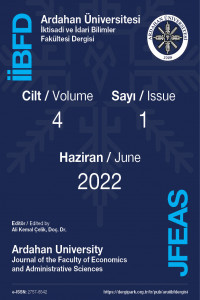Şehirleşme-sosyoekonomik gelişme ilişkisinin etki-tepki fonksiyonları ile analizi: Türkiye örneği
Ülkelerin refah düzeyi hakkında bilgi veren sosyoekonomik gelişmişlik ile toplum sağlığındaki iyileşmeler etkileşim içindedir. Bu çalışmada, Türkiye’de şehirleşme oranı ile doğumda beklenen yaşam süresi, gayrisafi yurtiçi hasıla ve doktor başına düşen kişi sayısı 1980-2019 yılları arası VAR analizi ve Granger nedensellik ile incelenmiştir. Elde edilen bulgulara göre doğumda beklenen yaşam süresi, gayrisafi yurtiçi hasıla, doktor başına düşen kişi sayısı biraraya gelerek şehirleşme oranına anlamlı etki sağlamaktadır. Ayrıca şehirleşme ve gayrisafi yurtiçi hasıla arasında anlamlı bir ilişki saptanmıştır. Ancak diğer değişkenler ile şehirleşme oranı arasında anlamlı ilişki bulunamamıştır. Ayrıca etki-tepki grafikleri aracılığıyla, bir değişkende meydana gelen şokun, diğer değişkenler üzerindeki etkisi gösterilmiştir.
Anahtar Kelimeler:
Şehirleşme, Sosyoekonomik Gelişme, Sağlık Hizmetlerine Erişim, Gayrisafi Yurtiçi Hasıla
Analysis of the urbanization-socioeconomic development relationship with impulse-response functions: the case of Turkey
Socio-economic development, which provides information about the welfare level of countries, and improvements in public health and urbanization are in interaction. In this study, the rate of urbanization, life expectancy at birth, gross domestic product and the number of people per doctor in Turkey between 1980 and 2019 were examined with VAR analysis and Granger causality. According to the findings, life expectancy at birth, gross domestic product, and the number of people per doctor come together to have a significant effect on the urbanization rate. In addition, a significant relationship was found between urbanization and gross domestic product. However, no significant relationship was found between other variables and the rate of urbanization. In addition, the effect of a shock in one variable on other variables is shown by means of impulse-response graphs
Keywords:
Urbanization, Socioeconomic Development, Access to Health Services, Gross Domestic Product,
___
- Davidson, R., MacKinnon, J., (1993), “Estimation and Inference in Econometrics”, 2nd ed. New York: Oxford University Press.
- Ghimire, P. R., Agho, K. E., Ezeh, O. K., and RENZAHO, A. M. (2019). Under-Five Mortality and Associated Factors: Evidence from the Nepal Demographic and Health Survey (2001–2016). International Journal Environment Research Public Health, (16).
- Girginer, N. (2013). A Comparison of the Healthcare Indicators of Turkey and The European Union Members Countries Using Multidimensional Scaling Analysis and Cluster Analysis. İktisat İşletme ve Finans, 28(323), pp.55-72.
- Gujarati, D. N., (2009), “Temel Ekonometri”, (Çev. Şenesen, U. ve Şenesen, G.G.), İstanbul: Literatür Yayıncılık.
- Kearney, C., Monadjemi, M., (1990), “Fiscal Policy And Current Ac¬count: International Evidence On The Twin Deficit”, Journal of Macroecono¬mics, 12(2), pp.197-217.
- Kocaman, A. M., vd., (2012). OECD Ülkelerinin Sağlık Sistemlerinin Etkinlik Analizi. Endüstri Mühendisleri Dergisi, 23(4), ss.14-31.
- Köksal, S. S., vd., (2016). Temel Sağlık Düzeyi Göstergeleri Açısından Türkiye ve Avrupa Birliği Ülkeleri. TJFMPC, ss.205-212.
- Lorcu, F., ve Polat, B. A. (2009). Yaşlara Göre Ölüm Oranları ile Sosyo-ekonomik Göstergeler Arasındaki İlişkinin İncelenmesi. İstanbul Üniversitesi İşletme Fakültesi Dergisi (38,2), ss.124-133.
- Malderen, C. V., et al., (2019). Socioeconomic Factors Contributing to Under-five Mortality in Sub-Saharan Africa: A Decomposition Analysis. BMC Public Health.
- Phillips, P. and Perron P., (1988). Testing for a unit root in time series regression, Biometrica, 75, pp. 335-346.
- Rostow, W. W. (1960). "The Five Stages of Growth-A Summary". The Stages of Economic Growth: A Non-Communist Manifesto. Cambridge: Cambridge University Press. pp. 4–16
- Seers, D. (1963). The Limitations of the Special Case, Bulletin of the Oxford Institute of Economics and Statistics, 25(2).
- Sen, A. (1999). Development as Freedom, New York, pp.15-25.
- Sims, C. A. (1980), “Macroeconomics and Reality”, Econometrica.
- UNDP, Human Development Report, (1990). http://hdr.undp.org/sites/default/files/reports/219/hdr_1990_en_complete_nostats.pdf (02.10.2021)
- UNICEF, (2019). https://www.unicef.org/turkey/bas%C4%B1n-b%C3%BCltenleri/bm-raporu-g%C3%BCn%C3%BCm%C3%BCzde-%C3%B6ncesine-g%C3%B6re-daha-fazla-kad%C4%B1n-ve-%C3%A7ocuk-hayatta-kal%C4%B1yor (11.04.2021)
- UNICEF, (2020). Levels & Trends in Estimates developed by the UN Inter-agency Group for Child Mortality Estimation United Nations Child Mortality, https://data.unicef.org/resources/levels-and-trends-in-child-mortality/ (20.02.2021)
- United Nation, (2000). Bin Yıl Kalkınma Hedefleri. https://www.tr.undp.org/content/turkey/tr/home/mdgoverview/overview/mdg4.html (10.11.2020)
- World Health Organization, (1958), The First ten years of the World Health Organization, https://web.archive.org/web/20200402025147/https://apps.who.int/iris/handle/10665/37089 (11.04.2021)
- World Health Organization. The Determinants of Health, https://web.archive.org/web/20191214054600/https://www.who.int/hia/evidence/doh/en/ (11.04.2021)
- ISSN: 2148-7154
- Yayın Aralığı: Yılda 2 Sayı
- Başlangıç: 2015
- Yayıncı: Ardahan Üniversitesi
Sayıdaki Diğer Makaleler
Yatırım gelişme yolu: Brezilya- Türkiye karşılaştırması
Şehirleşme-sosyoekonomik gelişme ilişkisinin etki-tepki fonksiyonları ile analizi: Türkiye örneği
İlknur Yeşim DİNÇEL, Gizem DİNÇEL
Etik liderlik üzerine hazırlanan lisansüstü tezlere yönelik bir inceleme
Seval AKSOY KÜRÜ, Gülden AKSOY
AHP ile çok kriterli ABC stok sınıflandırma üzerine bir uygulama
Muhasebe bilgi kalitesinin sermaye piysasalarına etkisi: BIST-50 üzerine bir uygulama
Muhasebe dersi alan öğrencilerin etik algısı: Kafkas ve Iğdır Üniversitesi örneği
Seyhan ÖZTÜRK, Osman Nuri AKARSU
Marmara Bölgesi’ndeki konteyner limanlarının etkinlik ölçümü ve potansiyel iyileştirme önerileri
